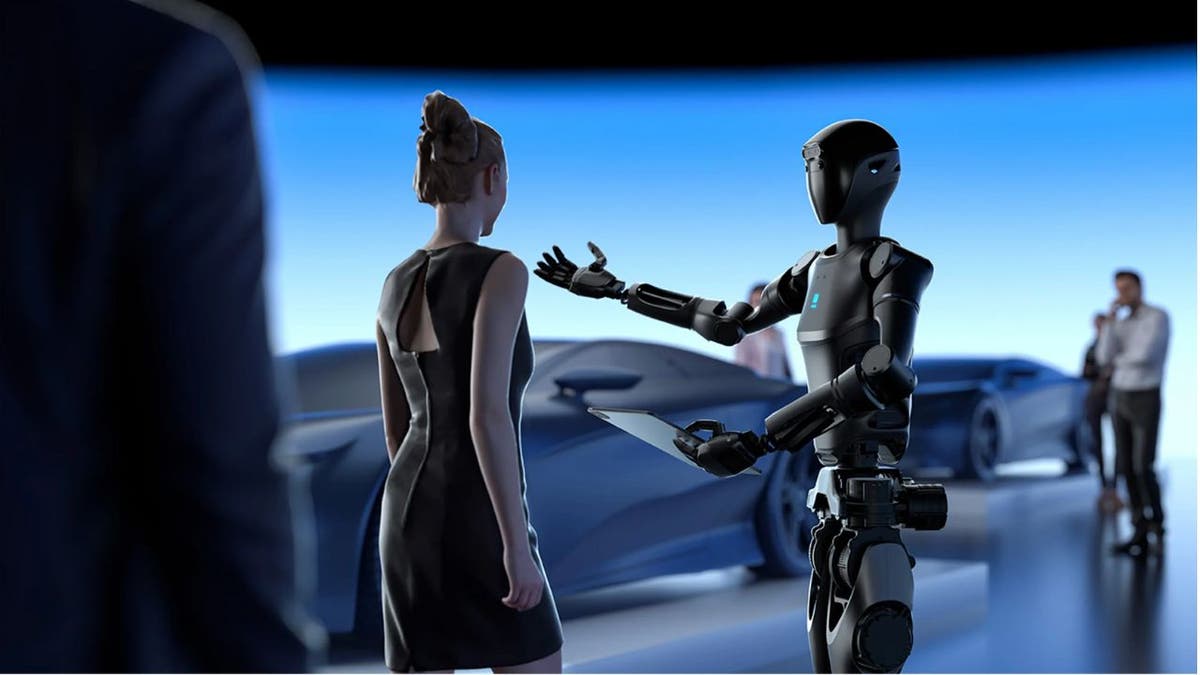When Kunitsu-Gami: Path of the Goddess debuted during Capcom’s digital summer showcase last year, I didn’t pay much attention. It looked like a high-concept action RPG based in Japanese mythology that took some of its artistic cues from another one of Capcom’s highly stylized games, Okami. And while I have nothing but love for action RPGs and Japanese folklore, nothing in that initial trailer, nor the ones that followed, showed me enough of what the game was about to be interesting.
Technology
Capcom’s Kunitsu-Gami combines tower defense strategy with the heart of community organizing
/cdn.vox-cdn.com/uploads/chorus_asset/file/25538593/Kunitsu_Gami_Gameplay_Screenshot___5_.png)
It was only after trying the game’s demo at this year’s Summer Game Fest, and later getting my hands on a copy, that I finally got it. And damn is this game worth getting into.
In Kunitsu-Gami: Path of the Goddess, you play as Soh, the guardian of the priestess Yoshiro who you must protect and guide through the land helping her purge it of evil demons. In an email to The Verge, art and game director Shuichi Kawata wrote that it wasn’t intentional that the marketing surrounding Kunitsu-Gami made it unclear what kind of game it was.
“This title is a mix of several genres,” Kawata wrote. “And we imagined the possibility that there would be a range of impressions people would have.”
I defy you to guess what kind of game this is based on this launch trailer.
Kawata described Kunitsu-Gami as a “maiden” defense game. Gameplay is divided into three parts: day, night, and a base-building cycle. During the day, Soh goes about mountain villages blighted by demonic corruption. He cleanses the corruption and rescues villagers who will help him in the night cycle to come. At night, demons attack, hoping to make their way to Yoshiro to kill her. To stop them, Soh assigns villagers different jobs, each with their own abilities, strengths, and weaknesses, and positions them throughout the village to prevent the demons from reaching Yoshiro. Once Yoshiro gets to the end of a village, it is permanently cleansed, making it a new base Soh and the villagers must repair before moving on to the next location.
I love how Kunitsu-Gami cleverly iterates on tower defense games. You assign roles to villagers with crystals, a resource gained through defeating demons at night and cleansing a village in the day. Not every villager can perform every role, and some roles aren’t combat viable, though they have other benefits. During a day cycle, I might assign a couple of my people to the thief role, sending them out to dig up more crystals or rations that act as health potions for Soh and the villagers. But thieves are useless at night, requiring me to burn up precious time and crystals to reassign and redeploy them. Sometimes, I might not have enough crystals, having used them all to buy the expensive sumo wrestler role — who draws demons’ attention to themselves and away from Yoshiro — or the acetic who uses their power to freeze demons in their place, making them easy pickings for the archer’s bow or the woodcutter’s axe.
Kunitsu-Gami offered the kind of challenge that makes my puzzle and strategy-obsessed brain sizzle with excitement
In addition to simply completing a stage, each village battle also comes with a set of special parameters that, if met, will get you extra goodies. One parameter required that I use no more than 1,900 crystals. While that initially seemed trivial, that goal got a lot harder to meet because that stage also required that I give 1,500 crystals to Yoshiro to complete it. I was then left with only 400 crystals for my villagers — an extremely tight budget when the basic roles like the archer and the woodcutter are 50 crystals a pop, while the more powerful roles cost between 150 to 300.
1/3
I really enjoyed that tension between strategic assignment and deployment. Do I spend the crystals to get the powerful roles, leaving me with fewer defenders? Or do I risk my larger but weaker army getting overrun? Kunitsu-Gami is also special in that it never fell into the trap of being too trivial. In other tower defense games, it’s possible to set your defenses so well that you can sit back and watch the game play itself. That never happened for me. No matter if I had a glut of resources and well-placed villagers, I always had to stay on high alert, often coming to Yoshiro’s rescue with one of Soh’s ultimate attacks. At every level, Kunitsu-Gami offered the kind of challenge that makes my puzzle and strategy-obsessed brain sizzle with excitement.
While it’s not a prominent feature, there’s also an interesting bit of narrative to the game. Each villager you rescue has a name and a bio, and I enjoyed reading their stories and how they all intertwined. These people became more than nameless units to throw at a demonic horde, but members of a living, breathing community made up of married couples, family, and friends. It made for a beautiful message that reminded me of the aphorism “we all we got.”
In Kunitsu-Gami, Soh is the only one with martial training while everyone else is farmers, fishermen, and housewives. Instead of waiting for outside help or succumbing to the relentless demons, those ordinary people took up what little arms they had to defend their homes and families. In a political climate that seems determined to roll back protections for women, queer people, and people of color, it’s nice to see that message. Help isn’t coming — we are the help. It’s a sentiment supported by what Kawata shared as Kunitsu-Gami’s main theme.
“Challenge is the driving ethos for this game,” he wrote. “We face various conditions seriously and push forward without fear.”
Kunitsu-Gami: Path of the Goddess is out now on PlayStation, PC, Xbox, and Xbox Game Pass.

Technology
How Watch Duty’s wildfire tracking app became a crucial lifeline for LA
/cdn.vox-cdn.com/uploads/chorus_asset/file/25824833/STKB309_WATCH_DUTY_B.jpg)
If you live in Los Angeles, you are probably already intimately familiar with Watch Duty, the free app that shows active fires, mandatory evacuation zones, air quality indexes, wind direction, and a wealth of other information that everyone, from firefighters to regular people, have come to rely on during this week’s historic and devastating wildfires.
Watch Duty is unique in the tech world in that it doesn’t care about user engagement, time spent, or ad sales. The 501(c)(3) nonprofit behind it only cares about the accuracy of the information it provides and the speed with which the service can deliver that information. The app itself has taken off, rocketing to the top of Apple’s and Google’s app stores. Over 1 million people have downloaded it over the last few days alone.
The elegance of the app lies in its simplicity. It doesn’t scrape user data, show ads, require any kind of login, or track your information. Its simple tech stack and UI — most of which is maintained by volunteer engineers and reporters — has likely helped save countless lives. While Watch Duty is free to use, the app accepts tax-deductible donations and offers two tiers of membership that unlock additional features, like a firefighting flight tracker and the ability to set alerts for more than four counties.
With plans to expand the service across the United States, as well as overseas and into other emergency services, Watch Duty may eventually replace some of the slower and less reliable local government alert systems for millions of people.
Photo by Lokman Vural Elibol / Anadolu via Getty Images
An app born from fire
The idea for Watch Duty came to cofounder John Mills while he was trying to protect his off-grid Sonoma County home from the Walbridge fire in 2020. He realized there wasn’t a single source for all the information people needed to protect themselves from the blaze, which ultimately killed 33 people and destroyed 156 homes. John and his friend David Merritt, who is Watch Duty’s cofounder and CTO, decided to build an app to help.
“This came out of an idea that John had, and he talked to me about it four years ago,” Merritt tells The Verge. “We built the app in 60 days, and it was run completely by volunteers, no full-time staff. It was a side project for a lot of engineers, so the aim was to keep it as simple as possible.”
Fire reporting is piecemeal at best in fire-prone areas and frequently scattered across platforms like Facebook and X, where fire departments and counties have verified pages sharing relevant updates. But increasingly, social media platforms are putting automated access for alert services behind paywalls. Governments also use a wide variety of alert systems, causing delays that can cost lives, especially in fast-moving fires like the Palisades and Eaton fires that have forced evacuations for more than 180,000 people. And sometimes, these government-run alerts are sent out mistakenly, causing mass confusion.
Watch Duty simplifies all that for millions of people.
“We view what we are doing as a public service,” says Merritt. “It is a utility that everyone should have, which is timely, relevant information for their safety during emergencies. Right now, it’s very scattered. Even the agencies themselves, which have the best intentions, their hands are tied by bureaucracy or contracts. We partner with government sources with a focus on firefighting.”
“We view what we are doing as a public service.”
One of the biggest issues around fires, in particular, is that they can move quickly and consume large swaths of land and structures in minutes. For example, the winds that drove the Palisades fire to spread to more than 10,000 acres reached 90 miles per hour on Tuesday. When minutes matter, the piecemeal alert system that Watch Duty replaces can cause delays that cost lives.
“Some of the delivery systems for push notifications and text messages that government agencies use had a 15-minute delay, which is not good for fire,” says Merritt. “We shoot to have push notifications out in under a minute. Right now, 1.5 million people in LA are getting push notifications through the app. That’s a lot of messages to send out in 60 seconds. In general, people are getting it pretty much all at the same time.”
A simple tech stack
For Watch Duty, this kind of mass communication requires reliable technology as well as a group of dedicated staff and skilled volunteers. Merritt says that Watch Duty relies on a number of corporate partners with whom it has relationships and contracts to provide its service.
“We shoot to have push notifications out in under a minute.”
The app is built on a mix of technology, including Google’s cloud platform, Amazon Web Services, Firebase, Fastly, and Heroku. Merritt says the app uses some AI, but only for internal routing of alerts and emails. Reporters at Watch Duty — those who listen to scanners and update the app with push notifications about everything from air drops to evacuation updates — are mostly volunteers who coordinate coverage via Slack.
“All information is vetted for quality over quantity,” he says. “We have a code of conduct for reporters. For example, we never report on injuries or give specific addresses. It’s all tailored with a specific set of criteria. We don’t editorialize. We report on what we have heard on the scanners.”
According to Merritt, the app has 100 percent uptime. Even though it started with volunteer engineers, the nonprofit has slowly added more full-time people. “We still have volunteers helping us, but it’s becoming more on the internal paid staff as we grow, as things get more complex, and as we have more rigorous processes,” he says.
“All information is vetted for quality over quantity.”
He says there are no plans to ever charge for the app or scrape user data. The approach is kind of the Field of Dreams method to building a free app that saves people’s lives: if you build it well, the funding will come.
“It’s the antithesis of what a lot of tech does,” Merritt says. “We don’t want you to spend time in the app. You get information and get out. We have the option of adding more photos, but we limit those to the ones that provide different views of a fire we have been tracking. We don’t want people doom scrolling.”
Photo by FREDERIC J. BROWN / AFP via Getty Images
Collecting information in the era of Trump
Watch Duty relies heavily on publicly available information from places like the National Weather Service and the Environmental Protection Agency. Should the incoming Trump administration decide to execute on threats to dismantle and disband the EPA (which monitors air quality) and the National Oceanic and Atmospheric Administration, the parent agency to the National Weather Service, such moves would impact Watch Duty’s ability to operate.
Even still, Merritt is optimistic. “We will be pretty well insulated from any change to policy,” he says. “We are either buying that information ourselves already or we are happy to buy it, and we will take that cost on. The fact that we’re soon going to be covering the entire US will defray the cost of anything that shifts from a policy perspective. Our operation costs are mostly salaries. We are trying to hire really good engineers and have a really solid platform. If we need to raise a grant to buy data from the National Weather Service, then we will.”
Regardless of what the next administration does, it’s clear that Watch Duty has become a critical and necessary app for those in Southern California right now. The app currently covers 22 states and plans to roll out nationwide soon.
“We got 1.4 million app downloads in the last few days,” according to Merritt. “I think we have only received 60 support tickets, so that shows that something is working there. We are really just focused on the delivery of this information.”
Technology
China’s newest humanoid robot is ready to serve like never before

Chinese startup Pudu Robotics has unveiled its latest creation, the D9 humanoid robot, designed to revolutionize the way we work and interact with machines.
Standing at an impressive 5.57 feet tall, this bipedal machine is not just another robot — it’s a versatile assistant ready to tackle a wide range of tasks in various settings.
D9 humanoid robot. (Pudu Robotics)
Capabilities and features of the humanoid robot
The D9 is no ordinary robot. With its ability to walk upright and carry loads up to 44 pounds, it’s built to handle real-world challenges. But what sets it apart from its predecessors?
I’M GIVING AWAY THE LATEST & GREATEST AIRPODS PRO 2
Advanced mobility: The D9 can walk at speeds of up to 4.5 mph, outpacing the average human stroll. It’s not just about speed, though. This robot can navigate stairs, slopes and even maintain balance when knocked off-kilter.
Intelligent navigation: Equipped with high-accuracy sensors, the D9 creates real-time 3D semantic maps of its surroundings. This allows for autonomous route planning and precise self-positioning.
Versatile applications: From performing ground cleaning tasks with the Pudu SH1 to carrying boxes in warehouses and stocking shelves in stores, the D9’s potential applications are vast.
Natural interaction: Perhaps most impressively, the D9 boasts “human-level multimodal natural interactions,” thanks to its sophisticated artificial intelligence processing frameworks.

D9 humanoid robot. (Pudu Robotics)
AI-POWERED ROBOT SINKS SEEMINGLY IMPOSSIBLE BASKETBALL HOOPS
The evolution of Pudu robotics
The D9 isn’t Pudu’s first foray into robotics. In September, they introduced the D7, a semi-humanoid robot on wheels designed for tasks like sorting components, serving in restaurants and operating elevators. The D9 builds on this foundation, expanding the range of possible applications.
WHAT IS ARTIFICIAL INTELLIGENCE (AI)?

D9 humanoid robot. (Pudu Robotics)
CHINESE HUMANOID ROBOT COULD BE THE FUTURE OF AFFORDABLE IN-HOME CARE
Competitive landscape
With the introduction of the D9, Pudu Robotics enters a competitive field alongside giants like Tesla and Unitree. While pricing details for the D9 are yet to be announced, it’s speculated to fall in the $20,000 to $30,000 range, similar to Tesla’s Optimus.

D9 humanoid robot. (Pudu Robotics)
ELECTRIC HUMANOID ROBOT POISED TO SHAKE UP THE JOB MARKET
Kurt’s key takeaways
The Pudu D9 showcases advanced mobility and intelligent interaction capabilities. As it prepares to enter the market, its potential impact on various industries could be profound, transforming how we approach tasks across sectors. The future looks promising for humanoid robots like the D9 as they pave the way for more efficient and interactive work environments.
What concerns do you have about the potential impact of humanoid robots like the Pudu D9 on the future of work and everyday life? Let us know by writing us at Cyberguy.com/Contact
For more of my tech tips and security alerts, subscribe to my free CyberGuy Report Newsletter by heading to Cyberguy.com/Newsletter
Ask Kurt a question or let us know what stories you’d like us to cover.
Follow Kurt on his social channels:
Answers to the most-asked CyberGuy questions:
New from Kurt:
Copyright 2025 CyberGuy.com. All rights reserved.
Technology
Intel still dreams of modular PCs — it brought a tablet laptop gaming handheld to CES
/cdn.vox-cdn.com/uploads/chorus_asset/file/25826491/PXL_20250106_223233485.jpg)
At CES 2025, Intel let journalists into its private “Innovation Showcase,” where we saw things like prototype next-gen laptops and giant stereo 3D handheld gaming PCs.
While I was there, I also spotted a heavy metal handheld on a table that didn’t seem… fully attached… to its screen. When I lifted the screen, it came away easily.
It felt suspiciously light to be a real tablet, so I flipped it over and saw three connectors underneath:
Above it, on a shelf, was a laptop with a suspiciously sized chunk of plastic on the bottom that looked like a perfect match. A minute later, Intel gaming evangelist Colin Helms confirmed: I was looking at a concept modular PC.
That module contains a complete Intel Lunar Lake computer, the entire guts you’d need to make one work outside of peripherals and screen. It’s basically a reboot of Intel’s abandoned Compute Card idea, except it’s not all Intel’s doing and you probably shouldn’t ever expect it to ship.
It’s a concept from Quanta, a company whose name you don’t typically see on the laptops and tablets they create, because Quanta is an ODM (like Compal, Pegatron, Wistron, and Apple’s better known iPhone supplier Foxconn) that designs and manufactures hardware on behalf of brand names.
Quanta’s calling the whole modular system the “AI8A,” and the aforementioned module at its heart is the “Detachable AI Core.” Helms told me it plugs into other concept computers as well, including an all-in-one desktop that Intel didn’t have to show off. And presumably, like the Compute Card idea, you could upgrade your computer just by putting a new new module into it.
The modular laptop has lots of concept-y bells and whistles too, so many that Intel’s CES staff hadn’t even worked them all out yet.
For starts, the laptop has a motorized hinge, so you can tell it to open and close its own lid; it also claims to offer eye-tracking that lets you sling around multitasking windows just by looking at where you’d like them to be. It apparently comes with a mouse integrated into a ring that you could wear.
The most mundane: a built-in Qi wireless charging pad in the palmrest, with indicator lights to show your battery’s remaining capacity.
I couldn’t try any of it working, unfortunately, nor did I manage to ask what “AI8A” means, because I mistakenly thought it said Aiba until I checked my photos closely just now. Nor could we hotswap the module between the handheld and laptop, since the module apparently doesn’t have a battery inside.
Again, this is a cool computing concept car: it’s not likely that this computer will ever ship, even in a more practical / less gadgety form. Thankfully, we have begun to see some real, practical modularity in the laptop space since the death of Intel’s Compute Card. Framework just celebrated its fifth anniversary this week, and Dell took a smaller step forward at CES with its first modular repairable USB-C port.
Photos by Sean Hollister / The Verge
-

 Politics1 week ago
Politics1 week agoNew Orleans attacker had 'remote detonator' for explosives in French Quarter, Biden says
-

 Politics1 week ago
Politics1 week agoCarter's judicial picks reshaped the federal bench across the country
-

 Politics1 week ago
Politics1 week agoWho Are the Recipients of the Presidential Medal of Freedom?
-

 Health6 days ago
Health6 days agoOzempic ‘microdosing’ is the new weight-loss trend: Should you try it?
-

 World1 week ago
World1 week agoSouth Korea extends Boeing 737-800 inspections as Jeju Air wreckage lifted
-
/cdn.vox-cdn.com/uploads/chorus_asset/file/25822586/STK169_ZUCKERBERG_MAGA_STKS491_CVIRGINIA_A.jpg)
/cdn.vox-cdn.com/uploads/chorus_asset/file/25822586/STK169_ZUCKERBERG_MAGA_STKS491_CVIRGINIA_A.jpg) Technology3 days ago
Technology3 days agoMeta is highlighting a splintering global approach to online speech
-

 World1 week ago
World1 week agoWeather warnings as freezing temperatures hit United Kingdom
-

 News1 week ago
News1 week agoSeeking to heal the country, Jimmy Carter pardoned men who evaded the Vietnam War draft














